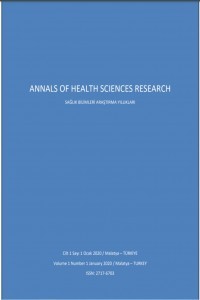Diyaliz Hastalarında Panel Reaktif Antikor Düzeyinin Tespiti: İki Yöntem ve İki Analizin Karșılaștırılması
PRA, ELISA, Luminex, Transplantasyon, Diyaliz
Detection of Panel Reactive Antibodies in Patients Under Dialysis: Comparison of Two Methods and Two Analysis
PRA, ELISA, Luminex, Transplantation, Dialysis,
___
- 1. Kurtulmuş Y, Ayna TK, Soyöz M, Özyılmaz B, Tanrısev M, Afacan G, Colak H, Pirim I. Comparision of Anti-HLA Antibodies of Kidney Transplant Candidates with Chronic Renal Failure by Two Different Methods: Flow-PRA and Luminex PRA. Transplant Proc 2013; 45(3): 875-7.
- 2. Picascia A, Infante T, Napoli C. Luminex and antibody detection in kidney transplantation. Clin Exp Nephrol 2012; 16(3): 373-81.
- 3. Huh KH, Kim MS, Kim HJ, Joo DJ, Kim BS, Ju MK, Kim SI, Kim YS. Renal transplantation in sensitized recipients with positive luminex and negative CDC (complement-dependent cytotoxicity) crossmatches. Transpl Int 2012; 25(11): 1131-7.
- 4. Fuggle SV, Martin S. Tools for Human Leukocyte Antigen Antibody Detection and Their Application to Transplanting Sensitized Patients. Transplantation 2008; 86(3): 384-90.
- 5. Jang JY, Kim YJ, Kim Y, Park YJ, Han K, Oh EJ. Aplication of calculated panel reactive antibody using HLA frequencies in Koreans. Ann Lab Med 2012; 32(1): 66-72.
- 6. Cecka JM. Calculated PRA (CPRA): The New Measure of Sensitization for Transplant Candidates. Am J Transplant 2010; 10(1): 26-9.
- 7. Gebel HM, Bray RA. Sensitizatio and sensitivity: defining the unsensitized patient. Transplantation 2000; 69(7): 1370-4.
- 8. MurpheyCL, Forsthuber TG. Trends in HLA antibody screening and identification and their role in transplantation. Expert Rev Clin Immunol 2008; 4(3): 391-9.
- 9. Kerman RH, Orosz CG, Lorber MI. Clinical Relevance of Anti-HLA Antibodies Pre and Post Transplant. Am J Med Sci 1997; 313(5): 275-8.
- 10. Elgueta S, Fuentes C, López M, Hernández J, Arenas A, Jiménez M, Gajardo JG, RodríguezH, LabrañaC. Effect of Implementing Anti-HLA Antibody Detection by Luminex in the Kidney Transplant Program in Chile. Transplant Proc 2011; 43(9): 3324-6.
- 11. Muro M, Llorente S, Gónzalez-Soriano MJ, Minguela A, Gimeno L, Alvarez-López MR. Pre-formed DonorSpecific Alloantibodies (DSA) Detected Only by Luminex Technology Using HLA-Coated Microspheres and Causing Acute Humoral Rejection and Kidney Graft Dysfunction. Clin Transpl 2006: 379-83.
- 12. Tait BD, Hudson F, Cantwell L, Brewin G, Holdsworth R, Bennett G, Jose M. Review article: Luminex technology for HLA antibody detection in organ transplantation. Nephrology (Carlton) 2009; 14(2): 247-54.
- 13. Barocci S, Valente U, Nocera A. Detection and analysis of HLA class I and class II specific alloantibodies in the sera of dialysis recipients waiting for a renal retransplantation. Clin Transpl 2007; 21(1): 47-56.
- 14. MishraMN, BaligaKV.Significance of panel reactive antibodie s in patients requiring kidney transplantation. Saudi J Kidney Dis Transpl 2013; 24(3): 495-9.
- 15. Colombo MB, Haworth SE, Poli F, Nocco A, Puglisi G, Innocente A, Serafini M, MessaP, ScalamognaM. Luminex technology for anti HLA antibody screening: evaluation of performance andof impact on laborato ryroutine. CytometryB Clin Cytom 2007;72(6): 465-71.
- 16. Jung S, Oh EJ, Yang CW, Ahn WS, Kim Y, Park YJ, Han K. Comparative Evaluation of ELISA and Luminex Panel Reactive Antibody Assays for HLA Alloantibody Screening. Korean J Lab Med 2009; 29(5): 473-80.
- 17. Ayna TK, Diler AS, Şentürk H, Gürtekin M, Çarin M. Flow Cytometry ile Panel Reaktif Antikorların Belirlenmesi. Klinik Gelişim. 2006. Cilt: 19, Say: 2
- Başlangıç: 2012
- Yayıncı: İnönü Üniversitesi
Zekeriya ÇALIŞKAN, Sermin Timur TAŞHAN, İlksen ORHAN, Gülçin NACAR
Gastroözefageal Reflü Hastalığı Tanısı Konan Çocuklarda Dental Erozyon Prevalansı
Tuğba BEZGİN, Zeynep Başak YILMAZ, Cansu KOÇYİĞİT, Nuray Uslu KIZILKAN, Ceyda Tuna KIRSAÇLIOĞLU, Nurhan ÖZALP
PTPN11 Gen Mutasyonu: Noonan Sendrom’lu Bir Olgu
Serdar KARATOPRAK, Emine YAŞAR, İbrahim TEKEDERELİ
Hemşirelerin Hastane Enfeksiyonlarını Önlemeye İlişkin Bilgi Düzeyleri
Talip MANKAN, Mağfiret Kara KAŞIKÇI
Elçin Latife KURTOĞLU, İdris ŞAHİN, Hülya TAŞKAPAN, Elif YEŞİLADA, Başak KAYHAN
